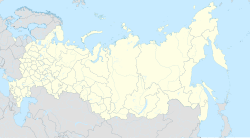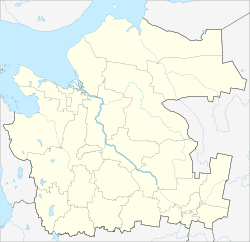Velsk (Russian: Вельск) is a town and the administrative center of Velsky District in Arkhangelsk Oblast, Russia, located on the left bank of the Vel River at its confluence with the Vaga River, 545 kilometers (339 mi) south of Arkhangelsk, the administrative center of the oblast. Population: 23,885 (2010 Census);[3] 26,241 (2002 Census);[7] 25,967 (1989 Soviet census).[8]
Velsk
Вельск | |
|---|---|
 Aerial view of Velsk | |
| Coordinates: 61°04′N 42°07′E / 61.067°N 42.117°E | |
| Country | Russia |
| Federal subject | Arkhangelsk Oblast[1] |
| Administrative district | Velsky District[1] |
| Town of district significance | Velsk[1] |
| First mentioned | 1137[2] |
| Elevation | 90 m (300 ft) |
| Population | |
• Total | 23,885 |
| • Capital of | Velsky District,[1] town of district significance of Velsk[1] |
| • Municipal district | Velsky Municipal District[4] |
| • Urban settlement | Velskoye Urban Settlement[4] |
| • Capital of | Velsky Municipal District,[4] Velskoye Urban Settlement[4] |
| Time zone | UTC+3 (MSK |
| Postal code(s)[6] | |
| OKTMO ID | 11605101001 |
| Website | www |
History
editFirst attested in 1137,[2] Velsk regularly suffered from inundations before it was moved to a higher spot in the 16th century. It was known as a pogost before 1555, as a posad between 1555 and 1780, whereupon it was incorporated as a town of Vologda Viceroyalty.[9] Velsk developed as a merchant town, having profited from its location on the Vaga and late on the road connecting Moscow and Arkhangelsk (which in the 17th century was the only major trade harbor in European Russia). Trade fairs were held in Velsk; the most important one was the St. Athanasius Trade Fair.
In 1796, Velsky Uyezd was transferred to Vologda Governorate and remained there until 1929, when several governorates were merged into Northern Krai. On July 15, 1929, the uyezds were abolished and Velsk became the administrative center of Velsky District, a part of Nyandoma Okrug of Northern Krai. In 1936, the krai was transformed into Northern Oblast and in 1937, Northern Oblast was split into Arkhangelsk Oblast and Vologda Oblast.
Administrative and municipal status
editWithin the framework of administrative divisions, Velsk serves as the administrative center of Velsky District.[1] As an administrative division, it is, together with the railway station of Vaga, incorporated within Velsky District as the town of district significance of Velsk.[1] As a municipal division, the town of district significance of Velsk, together with two rural localities in Ust-Velsky Selsoviet of Velsky District, are incorporated within Velsky Municipal District as Velskoye Urban Settlement.[4]
Economy
editIndustry
editTown's economy is dominated by timber industry. Vaga was used for timber rafting until the 1990s. Food production is also present.[10]
Transportation
editVelsk is located on the M8 Highway—one of the principal highways in Russia connecting Moscow and Arkhangelsk. The secondary roads lead east to Oktyabrsky and west to Konosha, branching off in Velsk.
Velsk has a railway station (since 1942) on the railroad connecting Konosha and Kotlas, which eventually continues to Vorkuta.
The Velsk Airport provided passenger service[11] until the 1990s, but has not been used since. In 2011, after a long break, a helicopter was tanked in Velsk. There are plans to use it as a base for the forest patrol aviation.
Culture and recreation
editThe historical center of Velsk, though having lost many of its historical buildings, conforms to the 1780 town plan and is regarded as a historically preserved area. In all, Velsk contains nineteen objects classified as cultural and historical heritage of local importance,[12] most of them being former merchant houses. The following objects are on the list:
- the whole architectural ensemble of Velsk
- Salnikov House (end of the 19th-beginning of the 20th century)
- Istomakhin House (1888)
- Shelovanova House (end of the 19th-beginning of the 20th century)
- Gorbunova House (1880)
- Orlov House (1885)
- Kotutin House (1902)
- Living House (end of the 19th-beginning of the 20th century)
- Trading House (end of the 19th-beginning of the 20th century)
- Transfiguration Cathedral (1898–1913)
- a house at 46 Dzerzhinsky Street
- a house at 49 Dzerzhinsky Street
- Assumption Church (wooden, 1795–1796)
- a house at 4 Komsomolskaya Street
- the ensemble of the Lenin Square, including the Popov house and a trading house
- prison church
- monument to the victims of the Civil War
Velsk hosts the Velsky District Museum.[13]
Education
editIn Velsk, there are five high schools, three high professional schools, two colleges (Velsk Agriculture College and Velsk College of Economics), and four regional branches of universities located elsewhere.[14]
Climate
edit| Climate data for Velsk | |||||||||||||
|---|---|---|---|---|---|---|---|---|---|---|---|---|---|
| Month | Jan | Feb | Mar | Apr | May | Jun | Jul | Aug | Sep | Oct | Nov | Dec | Year |
| Mean daily maximum °C (°F) | −11 (12) |
−8 (18) |
0 (32) |
6 (43) |
13 (55) |
18 (64) |
20 (68) |
17 (63) |
11 (52) |
3 (37) |
−2 (28) |
−7 (19) |
5 (41) |
| Daily mean °C (°F) | −12 (10) |
−10 (14) |
−3 (27) |
2 (36) |
9 (48) |
14 (57) |
16 (61) |
13 (55) |
8 (46) |
2 (36) |
−4 (25) |
−9 (16) |
2 (36) |
| Mean daily minimum °C (°F) | −15 (5) |
−12 (10) |
−6 (21) |
−2 (28) |
5 (41) |
10 (50) |
13 (55) |
10 (50) |
6 (43) |
1 (34) |
−6 (21) |
−11 (12) |
−1 (31) |
| Average precipitation days | 21 | 19 | 17 | 15 | 13 | 13 | 12 | 14 | 15 | 20 | 22 | 24 | 205 |
| Source: Weatherbase[15] | |||||||||||||
Notable people
edit- Georgii Karpechenko (1899–1941), Russian and Soviet biologist.
- Arseny Roginsky (1946–2017), Russian historian and human rights activist.
References
editNotes
edit- ^ a b c d e f g h Государственный комитет Российской Федерации по статистике. Комитет Российской Федерации по стандартизации, метрологии и сертификации. №ОК 019-95 1 января 1997 г. «Общероссийский классификатор объектов административно-территориального деления. Код 11 205», в ред. изменения №278/2015 от 1 января 2016 г.. (State Statistics Committee of the Russian Federation. Committee of the Russian Federation on Standardization, Metrology, and Certification. #OK 019-95 January 1, 1997 Russian Classification of Objects of Administrative Division (OKATO). Code 11 205, as amended by the Amendment #278/2015 of January 1, 2016. ).
- ^ a b Энциклопедия Города России. Moscow: Большая Российская Энциклопедия. 2003. p. 65. ISBN 5-7107-7399-9.
- ^ a b Russian Federal State Statistics Service (2011). Всероссийская перепись населения 2010 года. Том 1 [2010 All-Russian Population Census, vol. 1]. Всероссийская перепись населения 2010 года [2010 All-Russia Population Census] (in Russian). Federal State Statistics Service.
- ^ a b c d e Law #258-vneoch.-OZ
- ^ "Об исчислении времени". Официальный интернет-портал правовой информации (in Russian). June 3, 2011. Retrieved January 19, 2019.
- ^ Почта России. Информационно-вычислительный центр ОАСУ РПО. (Russian Post). Поиск объектов почтовой связи (Postal Objects Search) (in Russian)
- ^ Federal State Statistics Service (May 21, 2004). Численность населения России, субъектов Российской Федерации в составе федеральных округов, районов, городских поселений, сельских населённых пунктов – районных центров и сельских населённых пунктов с населением 3 тысячи и более человек [Population of Russia, Its Federal Districts, Federal Subjects, Districts, Urban Localities, Rural Localities—Administrative Centers, and Rural Localities with Population of Over 3,000] (XLS). Всероссийская перепись населения 2002 года [All-Russia Population Census of 2002] (in Russian).
- ^ Всесоюзная перепись населения 1989 г. Численность наличного населения союзных и автономных республик, автономных областей и округов, краёв, областей, районов, городских поселений и сёл-райцентров [All Union Population Census of 1989: Present Population of Union and Autonomous Republics, Autonomous Oblasts and Okrugs, Krais, Oblasts, Districts, Urban Settlements, and Villages Serving as District Administrative Centers]. Всесоюзная перепись населения 1989 года [All-Union Population Census of 1989] (in Russian). Институт демографии Национального исследовательского университета: Высшая школа экономики [Institute of Demography at the National Research University: Higher School of Economics]. 1989 – via Demoscope Weekly.
- ^ История города Вельск (in Russian). Администрация МО "Вельский муниципальный район. Retrieved August 25, 2011.
- ^ Промышленное производство Вельского муниципального района (in Russian). Администрация МО "Вельский муниципальный район". Retrieved August 25, 2011.
- ^ Котлас-Вельск-Архангельск на самолете (in Russian). Retrieved June 6, 2011.
- ^ Памятники истории и культуры народов Российской Федерации (in Russian). Russian Ministry of Culture. Retrieved June 2, 2016.
- ^ Вельский районный муниципальный краеведческий музей (in Russian). Российская сеть культурного наследия. Retrieved June 8, 2011.
- ^ Паспорт города (in Russian). Администрация МО "Вельское. 2009. Retrieved June 11, 2011.
- ^ "Weatherbase: Historical Weather for Vel'sk". Retrieved June 12, 2011.
Sources
edit- Архангельское областное Собрание депутатов. Областной закон №258-внеоч.-ОЗ от 23 сентября 2004 г. «О статусе и границах территорий муниципальных образований в Архангельской области», в ред. Областного закона №224-13-ОЗ от 16 декабря 2014 г. «Об упразднении отдельных населённых пунктов Соловецкого района Архангельской области и о внесении изменения в статью 46 Областного закона "О статусе и границах территорий муниципальных образований в Архангельской области"». Вступил в силу со дня официального опубликования. Опубликован: "Волна", №38, 8 октября 2004 г. (Arkhangelsk Oblast Council of Deputies. Oblast Law #258-vneoch.-OZ of September 23, 2004 On the Status and Borders of the Territories of the Municipal Formations in Arkhangelsk Oblast, as amended by the Oblast Law #224-13-OZ of December 16, 2014 On Abolishing Several Inhabited Localities in Solovetsky District of Arkhangelsk Oblast and on Amending Article 46 of the Oblast Law "On the Status and Borders of the Territories of the Municipal Formations in Arkhangelsk Oblast". Effective as of the day of the official publication.).




